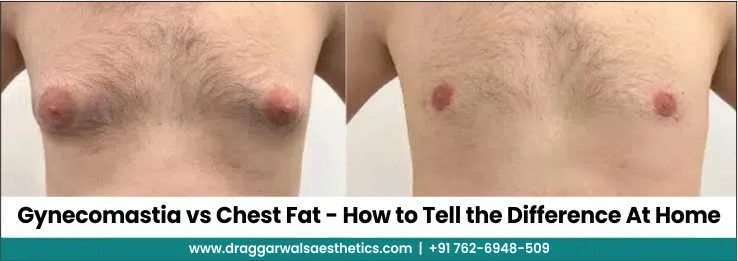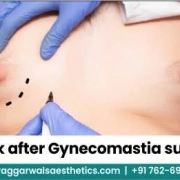Understanding the difference between gynecomastia and chest fat is important for both physical health and emotional well-being. Many men notice an enlargement of the chest area and start to wonder whether they are dealing with a buildup of fat or a medical condition. Although both conditions can look similar on the surface, they have different causes, characteristics, and treatments. This blog will help you understand how to distinguish between gynecomastia and chest fat at home, and what steps to take if you suspect either condition.
What Is Gynecomastia?
Gynecomastia is a condition that causes the enlargement of male breast tissue. It is not simply fat, it is the actual growth of glandular breast tissue. This can happen due to a hormonal imbalance, usually an increase in estrogen or a decrease in testosterone. Gynecomastia can affect one or both sides of the chest and may occur during different life stages, including infancy, adolescence, and older age. It can also be caused by certain medications, health conditions, or lifestyle factors such as alcohol or steroid use.
The key point is that gynecomastia involves the glandular tissue, which is firmer than fat and is often located directly behind the nipple. It is not related to weight gain, although someone who is overweight can also have gynecomastia in addition to chest fat.
What Is Chest Fat?
Chest fat, also known as pseudogynecomastia, is the result of excess fatty tissue accumulating in the chest area. Unlike gynecomastia, it is not due to glandular growth but rather from being overweight or having a higher body fat percentage. When a man gains weight, fat is distributed throughout the body, including the chest. This can give the appearance of “man boobs,” which often causes confusion with gynecomastia.
Chest fat is generally softer and more spread out across the chest area, whereas gynecomastia tends to be firmer and more localized around the nipple. Chest fat can typically be reduced through exercise and weight loss, while gynecomastia may not go away without medical intervention.
How to Tell the Difference at Home
While a proper diagnosis can only be made by a medical professional, there are a few things you can do at home to help determine whether you have gynecomastia or chest fat. Here are some practical steps:
-
Pinch Test
Stand in front of a mirror and gently pinch the area around your nipple using your thumb and forefinger. Feel for the consistency of the tissue. If you notice a rubbery or firm disk-like mass directly under the nipple, it may be gynecomastia. This glandular tissue feels denser and more solid than fat. On the other hand, if the tissue feels soft and squishy, and is spread out across a wider area, it’s more likely to be fat.
-
Symmetry
Gynecomastia can affect one or both breasts, but it often develops unevenly. You may notice one side of your chest is larger or firmer than the other. Chest fat usually accumulates more symmetrically, especially in those with overall high body fat. Uneven swelling or tenderness in just one breast is more suggestive of gynecomastia.
-
Sensitivity and Pain
Gynecomastia may be accompanied by pain or tenderness in the chest area. Some men report soreness around the nipple or a burning sensation. If you feel discomfort when you touch your chest or lie on it, that might be a sign of gynecomastia. Chest fat, on the other hand, does not typically cause pain unless it is associated with another issue such as skin irritation.
-
Nipple Appearance
In cases of gynecomastia, the nipple might protrude more than usual, and the areola (the dark area around the nipple) may appear swollen or puffed out. This is due to the presence of glandular tissue pushing outward. Chest fat does not usually affect the shape or contour of the nipple in the same way.
-
Body Fat Percentage
Consider your overall body composition. If you are overweight or obese, the enlarged chest is more likely to be fat. Men with lower body fat percentages who still notice significant swelling or tenderness in the chest should consider the possibility of gynecomastia. It is also possible for a person to have both conditions simultaneously, this is especially true for overweight individuals who develop glandular growth as well.
-
Changes Over Time
Gynecomastia may develop gradually or suddenly, depending on the cause. If you’ve noticed a rapid change in your chest size without a corresponding change in your weight, it could be gynecomastia. In contrast, chest fat typically increases or decreases in line with your overall weight changes. Pay attention to your body over a few weeks or months. If you’re losing weight but your chest isn’t changing much, it could be a sign that it’s not just fat.
Common Causes of Each Condition
Understanding what leads to each condition can also help you determine which one you’re dealing with. Gynecomastia is commonly caused by:
- Hormonal imbalances
- Puberty (often resolves on its own)
- Aging (natural drop in testosterone)
- Use of anabolic steroids or certain medications
- Alcohol, marijuana, or drug use
- Chronic illnesses such as liver or kidney disease
Chest fat, in contrast, is usually linked to:
- Poor diet
- Lack of exercise
- High body fat percentage
- Genetic predisposition to store fat in the chest area
Psychological and Emotional Impact
Regardless of whether you’re dealing with gynecomastia or chest fat, both conditions can have a significant emotional effect. Men may feel self-conscious about taking their shirts off in public or avoid certain activities like swimming. The psychological toll can include lower self-esteem, embarrassment, and even anxiety or depression. That’s why identifying the issue and addressing it, either through lifestyle changes or medical advice, is so important.
When to Seek Medical Advice
If you’re unsure about what you’re experiencing, or if you’ve tried to reduce chest fat through diet and exercise without noticeable improvement, it’s wise to see a healthcare provider. In some cases, gynecomastia can be a symptom of an underlying medical condition that requires attention. A doctor can conduct a physical exam, review your medical history, and, if necessary, order blood tests or imaging like an ultrasound or mammogram to confirm the diagnosis.
For those diagnosed with gynecomastia, treatment options vary. Some cases resolve naturally, especially in teenagers going through puberty. Others may benefit from medication, especially if the condition is caused by a hormonal imbalance. In more severe or persistent cases, surgical intervention such as male breast reduction may be considered.
What You Can Do Right Now
If you suspect chest fat is the cause, begin by adopting a consistent exercise routine that includes both cardio and strength training. Focus on full-body fat loss rather than targeting the chest area alone. Combine this with a clean, balanced diet rich in whole foods and low in processed sugars and unhealthy fats.
If gynecomastia seems more likely, avoid self-medicating or trying unproven treatments. Track your symptoms and consider scheduling a consultation with a doctor or endocrinologist for proper evaluation.
Conclusion
Telling the difference between gynecomastia and chest fat at home is possible if you pay close attention to the feel, shape, and sensitivity of your chest. While both conditions can affect your confidence, understanding what you’re dealing with is the first step toward a solution. Whether it’s lifestyle changes for fat reduction or medical treatment for glandular growth, there are effective ways to regain your comfort and confidence. Listen to your body, be patient with the process, and don’t hesitate to seek help if you need it.









Leave a Reply
Want to join the discussion?Feel free to contribute!